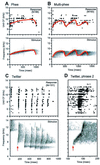On cortical coding of vocal communication sounds in primates
- PMID: 11050218
- PMCID: PMC34358
- DOI: 10.1073/pnas.97.22.11843
On cortical coding of vocal communication sounds in primates
Abstract
Understanding how the brain processes vocal communication sounds is one of the most challenging problems in neuroscience. Our understanding of how the cortex accomplishes this unique task should greatly facilitate our understanding of cortical mechanisms in general. Perception of species-specific communication sounds is an important aspect of the auditory behavior of many animal species and is crucial for their social interactions, reproductive success, and survival. The principles of neural representations of these behaviorally important sounds in the cerebral cortex have direct implications for the neural mechanisms underlying human speech perception. Our progress in this area has been relatively slow, compared with our understanding of other auditory functions such as echolocation and sound localization. This article discusses previous and current studies in this field, with emphasis on nonhuman primates, and proposes a conceptual platform to further our exploration of this frontier. It is argued that the prerequisite condition for understanding cortical mechanisms underlying communication sound perception and production is an appropriate animal model. Three issues are central to this work: (i) neural encoding of statistical structure of communication sounds, (ii) the role of behavioral relevance in shaping cortical representations, and (iii) sensory-motor interactions between vocal production and perception systems.
Figures




Similar articles
-
How do auditory cortex neurons represent communication sounds?Hear Res. 2013 Nov;305:102-12. doi: 10.1016/j.heares.2013.03.011. Epub 2013 Apr 17. Hear Res. 2013. PMID: 23603138 Review.
-
Cortical processing of complex sounds.Curr Opin Neurobiol. 1998 Aug;8(4):516-21. doi: 10.1016/s0959-4388(98)80040-8. Curr Opin Neurobiol. 1998. PMID: 9751652 Review.
-
Auditory cortex of bats and primates: managing species-specific calls for social communication.Front Biosci. 2007 May 1;12:4621-40. doi: 10.2741/2413. Front Biosci. 2007. PMID: 17485400 Free PMC article. Review.
-
Two organizing principles of vocal production: Implications for nonhuman and human primates.Am J Primatol. 2011 Jun;73(6):530-44. doi: 10.1002/ajp.20913. Epub 2010 Dec 22. Am J Primatol. 2011. PMID: 21509789 Review.
-
Cortical representations of communication sounds.Curr Opin Otolaryngol Head Neck Surg. 2008 Oct;16(5):478-84. doi: 10.1097/MOO.0b013e32830e6dac. Curr Opin Otolaryngol Head Neck Surg. 2008. PMID: 18797292 Review.
Cited by
-
Balance or imbalance: inhibitory circuits for direction selectivity in the auditory system.Cell Mol Life Sci. 2015 May;72(10):1893-906. doi: 10.1007/s00018-015-1841-2. Epub 2015 Feb 1. Cell Mol Life Sci. 2015. PMID: 25638210 Free PMC article. Review.
-
Evolutionary continuity and divergence of auditory dorsal and ventral pathways in primates revealed by ultra-high field diffusion MRI.Proc Natl Acad Sci U S A. 2024 Feb 27;121(9):e2313831121. doi: 10.1073/pnas.2313831121. Epub 2024 Feb 20. Proc Natl Acad Sci U S A. 2024. PMID: 38377216 Free PMC article.
-
An operant conditioning method for studying auditory behaviors in marmoset monkeys.PLoS One. 2012;7(10):e47895. doi: 10.1371/journal.pone.0047895. Epub 2012 Oct 24. PLoS One. 2012. PMID: 23110123 Free PMC article.
-
The laminar and temporal structure of stimulus information in the phase of field potentials of auditory cortex.J Neurosci. 2011 Nov 2;31(44):15787-801. doi: 10.1523/JNEUROSCI.1416-11.2011. J Neurosci. 2011. PMID: 22049422 Free PMC article.
-
Development of inhibitory mechanisms underlying selectivity for the rate and direction of frequency-modulated sweeps in the auditory cortex.J Neurosci. 2007 Feb 14;27(7):1769-81. doi: 10.1523/JNEUROSCI.3851-06.2007. J Neurosci. 2007. PMID: 17301184 Free PMC article.
References
-
- Penfield W, Roberts L. Speech and Brain-Mechanisms. Princeton, NJ: Princeton Univ. Press; 1959.
-
- Heffner H E, Heffner R S. J Neurophysiol. 1986;56:683–701. - PubMed
-
- Brodmann K. Vergleichende Lokalisationslehre der Grobhirnrinde. Leipzig: Barth; 1909.
-
- Jones E G, Powell T P S. Brain. 1970;93:793–820. - PubMed
-
- Pandya D N, Yeterian E H. In: Cerebral Cortex. Peters A, Jones E G, editors. Vol. 4. New York: Plenum; 1985. pp. 3–61.
Publication types
MeSH terms
Grants and funding
LinkOut - more resources
Full Text Sources

